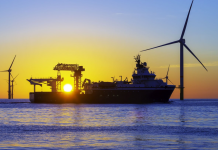
Researchers working with Maersk published the results of a long-term study focusing on vessel designs that would reduce radiated noise levels and source levels from commercial ships sailing in the ocean. Produced in a collaboration between Maersk and researchers at UC San Diego’s Scripps Institution of Oceanography, the report contains the first long-term data set measuring hundreds of trips both before and after a significant refit program undertaken by Maersk to its G-class containerships. The researchers hope the data will contribute to the efforts by the International Maritime Organization and others focusing on reducing noise radiating from shipping.
The effort focused on the Santa Barbara Channel, a heavily trafficked shipping route off Southern California where the Scripps team has been recording and measuring the marine soundscape for decades. They use instruments known as High-Frequency Acoustic Recording Packages, or HARPs, that have an underwater microphone, or hydrophone, sitting on the seafloor at a depth of 1,900 feet.
“This paper was a first step in assessing whether retrofitting had an impact on noise levels,” said Vanessa ZoBell, a Scripps Ph.D. student and lead author of the study which was published in the journal PLOS One. “It was an interdisciplinary effort involving marine scientists, industry, naval architects, and policy experts.”
The research collaboration started following Maersk’s completion of a $1 billion, five-year “Radical Retrofit” initiative focused on improving energy efficiency and fuel consumption to reduce emissions. During this effort, 12 of Maersk’s G-class containerships (115,700 dwt) were retrofitted from 2015 through 2018. The vessels had been built a decade earlier. The 1,200-foot ships underwent alterations including a redesign or replacing of the bulbous bow to reduce drag, derating the main engines for slow steaming, and installing more efficient, four-bladed propellers with propeller boss cap fins to reduce cavitation. The result also raised the vessels’ carry capacity by approximately 1,000 boxes with Maersk reporting they now have a nominal capacity of approximately 11,000 TEU.
Researchers were able to isolate a total of 177 transits recorded between 2008 and 2018 aboard the G-class pre and post the renovations as they made their way to and from the ports of Los Angeles and Long Beach. They assembled a dataset from 111 transits from these ships. They excluded 66 transits because of the presence of singing whales or other acoustic interference.
The study identified retrofit-induced changes in the ships’ radiated noise levels and monopole source levels. Radiated noise measurements account for the distance between the recording device (such as the hydrophone) and the sound it is recording (the ship noise) by correcting for the distance in-between the ship and the recorder. Monopole source levels account for what you would hear if you were positioned one meter away from the source, which in commercial ships is predominantly the sound from propeller cavitation or pressure-related water cavities due to propeller motion.
The team identified a significant decrease in monopole source levels in the low-frequency band by over five decibels post-retrofitting. This noise reduction was likely due to the changes in the propeller and bow design, wrote the authors.
Post-retrofit, they also measured a slight increase in the radiated noise level from the ships, likely due to the increased number of containers stacked on top of the retrofitted vessels. The additional weight likely caused the vessels to sit deeper in the water, changing their draft. The authors note that while noise levels rose from one perspective, the increased cargo capacity will lead to fewer trips and thereby reduce ocean noise. The interaction between retrofit and speed in this study was also noteworthy, highlighting that the effect of retrofitting on the monopole source level was greatest at slower speeds.
“One of the goals of the vessel retrofit was to add more containers, allowing the ship to transport more cargo,” said John Hildebrand, principal investigator of the Scripps Whale Acoustics Lab and a co-author on the study. “This changed the draft of the ship which had an impact on the noise. It forced us to think about the noise relative to the number of containers transported, which was a new perspective.”
Because multiple design changes occurred at once in the retrofitted ships highlighted in this study, it was difficult for the authors to disentangle which changes were most effective in reducing sound levels, so further research in this area is needed.
“Underwater noise is increasingly recognized as an important environmental factor, and is starting to be addressed at the International Maritime Organization level,” said Lee Kindberg, head of Environment and Sustainability for Maersk North America and a study co-author who was instrumental in the collaboration. “The team at Scripps has unique expertise in this area. It is clear that we need additional info to design most effectively to both reduce underwater noise and greenhouse gas emissions. The best solution must address both of these issues.”
The new paper is the latest in a series of studies done from the dataset. The authors concluded by recommending that future studies further test the noise reductions found in this study with larger sample sizes, different ship types, and different design approaches to identify the most efficient methods for reducing underwater noise on an international level.
Source – THE MARITIME EXECUTIVE




